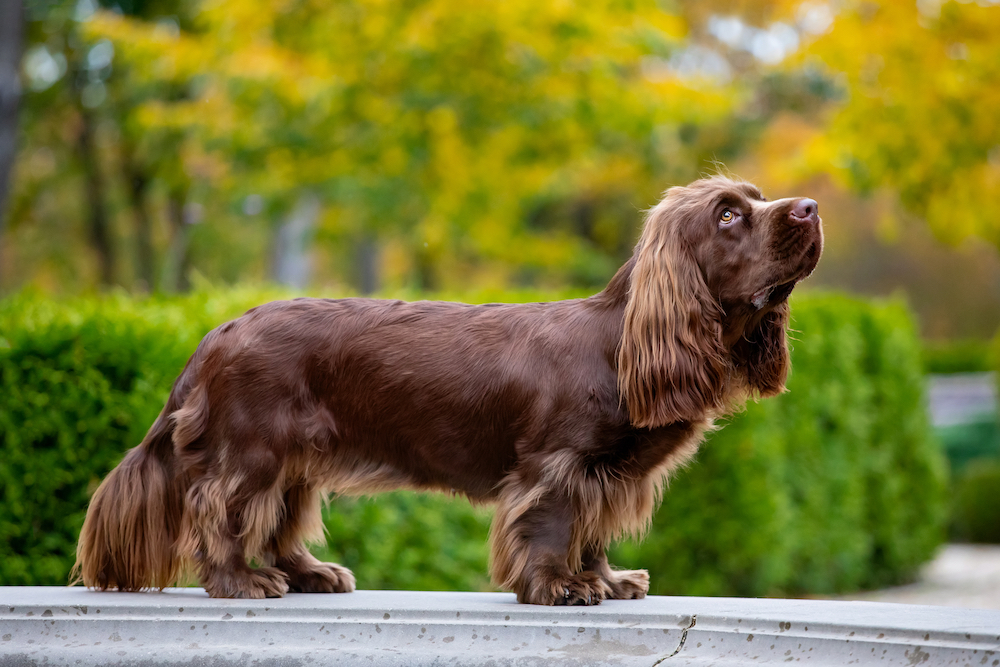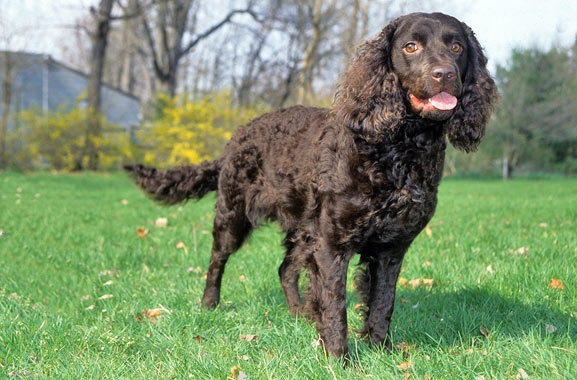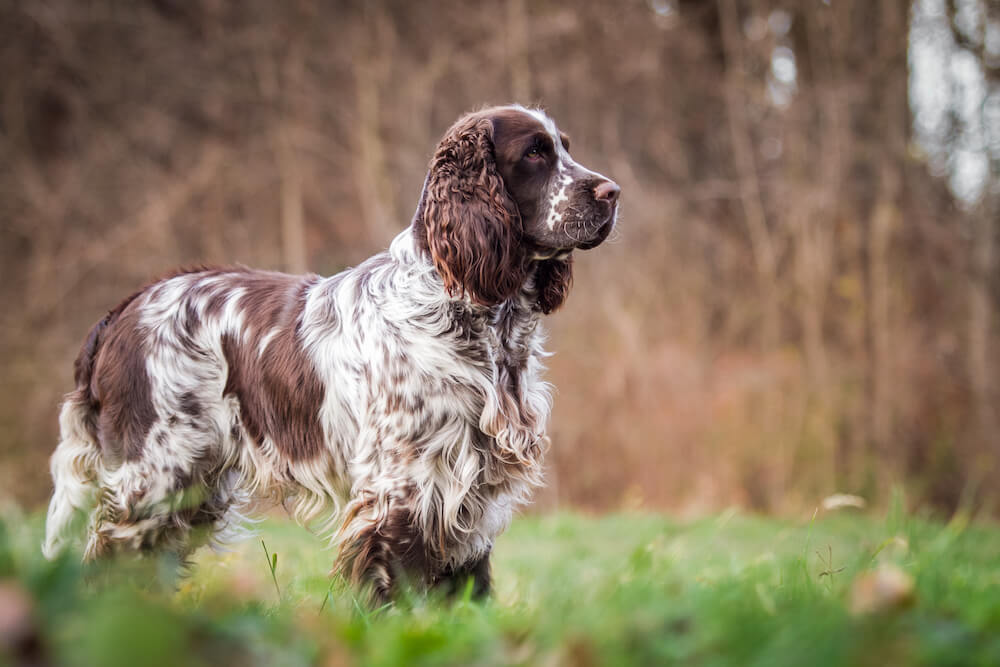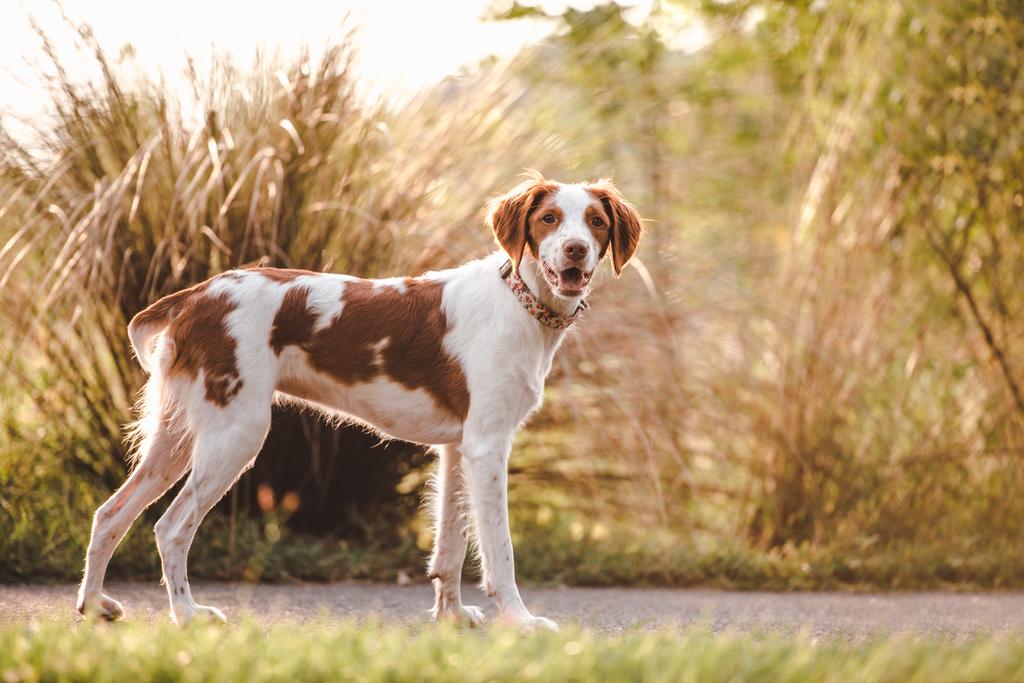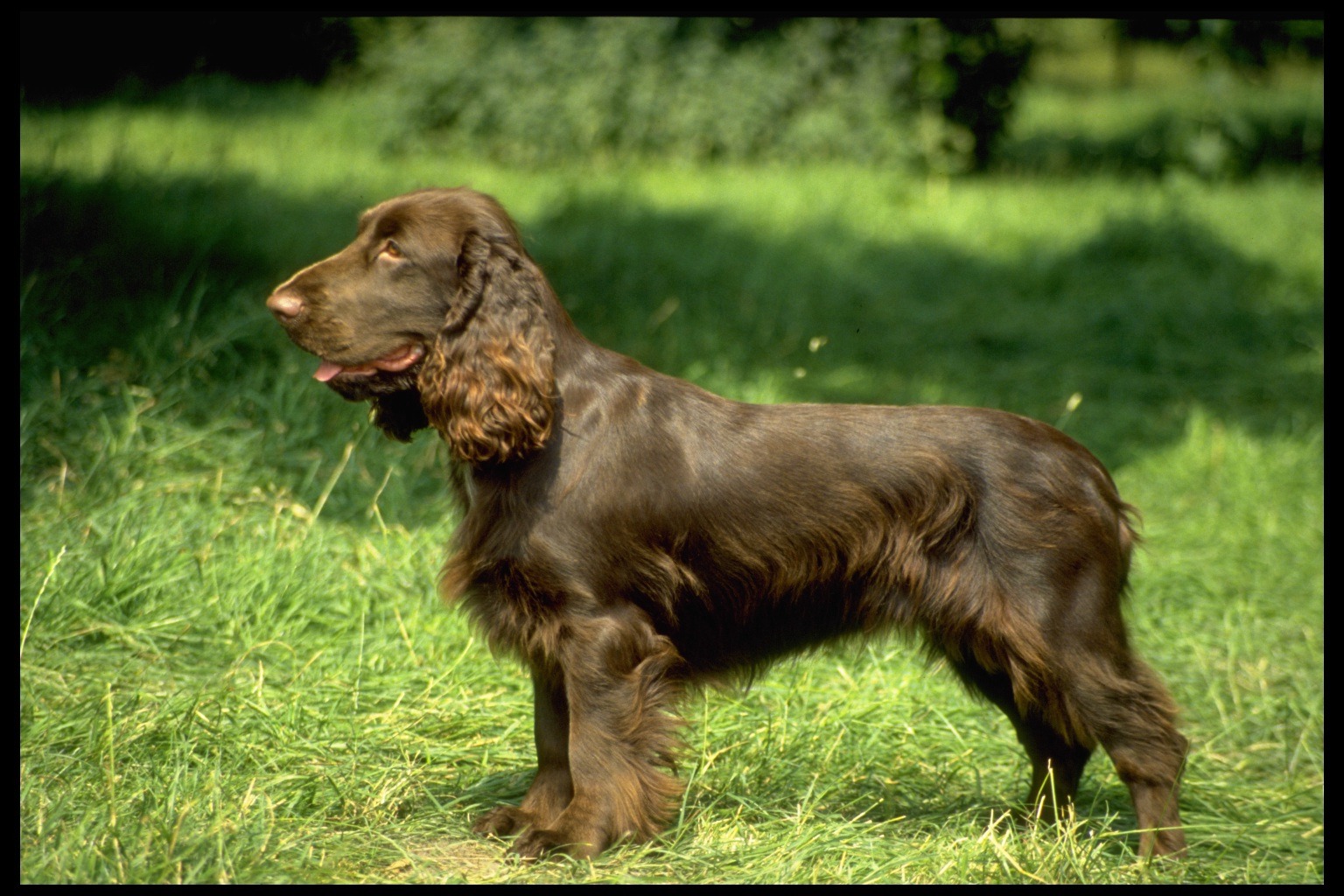The first time I encountered a Sussex Spaniel at a dog show, I was immediately charmed by its uniqueness. With a rich golden-liver coat that seemed to glow in the sunlight, a surprisingly substantial body for a medium-sized dog, and the most soulful expression I’d ever seen, this dog stood out among the more common spaniel breeds. But what truly caught my attention came next – as someone approached the dog, it let out a series of distinctive, almost musical barks that seemed far too deep and melodious for its size. “That’s a Sussex for you,” the handler laughed. “They’re famous for their voices!”
Here at pawtrix.wiki, we’re passionate about highlighting lesser-known dog breeds that deserve more attention, and the Sussex Spaniel certainly qualifies. As one of the rarest AKC-recognized breeds and officially listed as a “vulnerable native breed” in its homeland of the UK, these golden-liver hunting dogs combine the classic spaniel virtues of determination and trainability with some distinctly unique characteristics all their own.
Whether you’re seriously considering adding one to your family or simply curious about this distinctive breed with the unusual voice and cheerful temperament, there’s a lot to learn about Sussex Spaniels. Their history dating back to the 1800s in a specific region of England, their near-extinction during World War II, and their remarkable resurrection by dedicated breeders are just part of what makes these dogs special.
So grab your favorite beverage, get comfy, and let’s dive into everything you need to know about Sussex Spaniels—from their fascinating history to what it’s really like sharing your home with these vocal, affectionate companions. By the end of this post, you’ll understand why Sussex Spaniel enthusiasts are so devoted to preserving and celebrating this wonderful but uncommon breed.
English Heritage: The Spaniel from Sussex
The Sussex Spaniel has a rich history deeply rooted in a specific region of England, with a development story that reflects both the practical needs of hunters and the challenges faced by many dog breeds during wartime.
Development in Sussex County
As the name clearly indicates, the Sussex Spaniel originated in Sussex County in southern England. The breed was developed in the late 1700s and early 1800s primarily at Rosehill Park, the estate of Mr. Augustus Elliott Fuller. Fuller wanted a hunting spaniel specifically adapted to the heavy clay soil and thick undergrowth found in the Sussex region – conditions that required a strong, sturdy dog with powerful legs and a low-slung body that could push through dense cover.
Unlike many sporting breeds developed by crossing various existing types, the Sussex Spaniel appears to have been created through selective breeding of spaniels already existing in the area. This focused, regional development helped create a dog with consistent type and working ability specifically tailored to local hunting conditions.
The Sussex Spaniel’s distinctive golden-liver color became a hallmark of the breed, helping hunters spot their dogs while working in heavy cover. Their unique vocalizations – a trait not common among spaniels – also proved useful, allowing handlers to track their dogs’ locations and activities even when out of sight in thick undergrowth.
Recognition and Early Popularity
The Sussex Spaniel was among the earliest breeds recognized by The Kennel Club in the United Kingdom, included in the very first stud book in 1859. This early recognition speaks to the breed’s established type and importance in English sporting circles.
In the mid-19th century, Sussex Spaniels enjoyed modest popularity among the landed gentry who appreciated their hunting abilities in the specific terrain of southern England. They were exhibited at early dog shows and maintained primarily as working gundogs rather than companions or show dogs.
The American Kennel Club recognized the Sussex Spaniel in 1884, making it one of the earliest recognized breeds in the United States. Despite this early recognition, the breed never achieved widespread popularity in America, remaining a specialized choice for knowledgeable sporting dog enthusiasts.
Near-Extinction and Revival
Like many breeds, the Sussex Spaniel faced a crisis during World War II. Food rationing, the luxury tax on sporting dogs, and the general focus on war efforts rather than dog breeding caused numbers to dwindle drastically. By the end of the war, the breed was on the brink of extinction, with only a handful of dogs remaining.
The Sussex Spaniel’s salvation came primarily through the dedication of English breeder Joy Scholefield. In a last-ditch effort to save the breed, she gathered the few remaining Sussex Spaniels and began a careful breeding program. This program necessarily involved some limited outcrossing to Field Spaniels to maintain genetic diversity, but always with the goal of preserving the Sussex Spaniel’s distinctive type and character.
Through these efforts, the breed was slowly rebuilt, though it remains one of the rarest spaniel varieties worldwide. Today, the Sussex Spaniel is listed as a “vulnerable native breed” by The Kennel Club in the United Kingdom, meaning annual registrations number fewer than 300. In the United States, they typically rank among the least common breeds registered with the American Kennel Club.
This rarity is both a blessing and a challenge – it has helped maintain a focus on quality and preservation rather than commercial popularity, but it also means that finding a Sussex Spaniel requires patience and commitment.
Distinctive Appearance: The Golden-Liver Beauty
Sussex Spaniels have a highly distinctive appearance that sets them apart from all other spaniel breeds. Their unique combination of color, structure, and expression creates a dog that is immediately recognizable to those familiar with the breed.
Size and Structure: Substantial and Low-Slung
Sussex Spaniels have a distinctive body structure:
- Medium-sized, standing 13-15 inches at the shoulder
- Substantial weight of 35-45 pounds, making them heavy for their height
- Rectangular body that is noticeably longer than tall
- Low-set body with relatively short, powerful legs
- Deep chest, strong bone, and well-developed musculature
This structure was purposefully developed to allow the dogs to push through the heavy underbrush and difficult terrain of Sussex County. Their low center of gravity and substantial build gave them the strength and stability to work all day in challenging conditions.
Modern Sussex Spaniels maintain this distinctive build, though show-bred dogs are often somewhat heavier and more substantial than their working ancestors. The breed standard emphasizes power, strength, and substance over speed – these are methodical hunters, not racing dogs.
The Signature Golden-Liver Coat
Perhaps the most immediately striking feature of the Sussex Spaniel is their rich, unique color:
- Always and only a rich golden-liver color
- Distinctive warm, reddish-brown shade that appears to glow in sunlight
- Never light liver, red, or chocolate brown
- Gold tipping on some hairs creates depth and richness
- Small white mark on chest allowed but not preferred
This consistent color is a defining characteristic of the breed. While many spaniel breeds come in various colors, the Sussex is limited to this single, distinctive shade. The rich golden-liver helped hunters spot their dogs in dense cover and has become a hallmark of breed type.
The coat itself is flat or slightly wavy, dense and weather-resistant, with moderate feathering on the ears, chest, legs, and tail. It’s neither as profuse as some show spaniels nor as sparse as field-bred sporting dogs, striking a practical balance between protection and maintenance.
The Expressive Face
A Sussex Spaniel’s face and expression are particularly characteristic:
- Large, hazel eyes with a thoughtful, somewhat somber expression
- Pronounced eyebrows that enhance their expressive look
- Long, low-set ears covered with silky hair
- Square, substantial muzzle with well-developed flews (lips)
- Overall expression often described as “serious” or “thoughtful”
There’s something uniquely soulful about a Sussex Spaniel’s expression – despite their generally cheerful temperament, their face often carries a somewhat grave, dignified look. This contrast between their somber expression and typically happy disposition is part of their charm.
Movement and Presence
When a Sussex Spaniel moves, you can see their distinctive structure in action. Their gait is deliberate and rolling rather than fast or flashy, with powerful drive from behind and good reach in front despite their relatively short legs. They move with purpose rather than speed, reflecting their development as methodical hunters.
Standing still, they present a picture of sturdy dignity – substantial, low to the ground, with a level topline and that rich golden-liver coat gleaming in the light. They don’t have the flashy elegance of some sporting breeds, but rather a workmanlike, practical beauty that speaks to their hunting heritage.
The Sussex Personality: Cheerful Determination
Behind the Sussex Spaniel’s somewhat serious expression lies a temperament that combines classic spaniel enthusiasm with some distinctive characteristics that set them apart from their spaniel cousins.
The Happy Worker
Sussex Spaniels approach life with a blend of determination and good cheer:
- Enthusiastic about activities with their people
- Happy disposition that contrasts with their sometimes somber expression
- Determined workers who don’t give up easily on tasks
- Methodical rather than frantic in their approach
- Genuine joy in both work and play
This combination of cheerfulness and determination made them effective hunting companions – they had the persistence to work through difficult cover but maintained a positive attitude through challenging conditions. In modern homes, it translates to dogs who approach training and activities with enthusiasm while having the perseverance to master new skills.
The Vocal Spaniel
One of the most distinctive personality traits of the Sussex Spaniel is their vocalization:
- Known for their unique, almost musical barking
- May “talk” with a variety of interesting sounds
- Historically used their voice while hunting (unlike most spaniels)
- Often vocal when excited or working
- Distinctive deep tone that seems surprising for their size
This vocalization is actually part of their working heritage – Sussex Spaniels were developed to “give tongue” (bark) while working, allowing hunters to track their location in dense undergrowth. Modern Sussex Spaniels maintain this trait, making them more vocal than many sporting breeds. Potential owners should appreciate this characteristic rather than considering it a fault.
Family Bonds and Social Nature
Sussex Spaniels form strong bonds with their people:
- Deeply devoted to their families
- Thrive on inclusion in household activities
- Generally excellent with children when properly socialized
- Typically good with other dogs and pets
- May be somewhat reserved with strangers initially
Their social nature makes them poor candidates for isolation – Sussex Spaniels want to be where their people are, participating in family activities. They typically bond with all family members rather than becoming a one-person dog, though they may show special attachment to whoever spends the most time with them or engages in their favorite activities.
While naturally friendly, they may show some initial reserve with strangers – not fearfulness or aggression, but a momentary caution before deciding someone is friend rather than foe. Early socialization helps ensure this reserve remains appropriate and doesn’t develop into shyness.
Energy Level and Exercise Needs
Sussex Spaniels have moderate to high energy levels that require regular outlets:
- Need daily exercise but not as frenetic as some sporting breeds
- Enjoy walks, play sessions, and exploration
- Many enjoy swimming and retrieving games
- Mental stimulation as important as physical exercise
- Good “off switch” in the home when properly exercised
Their energy tends to be sustainable rather than explosive – they were developed for endurance over a day’s hunt rather than bursts of speed. This translates to dogs who enjoy regular, moderate exercise rather than demanding extreme physical challenges.
What’s particularly nice about Sussex Spaniels is their adaptability – while they certainly need daily exercise, they can adjust to their owner’s lifestyle to some extent, being energetic companions for activities but also capable of relaxing at home between adventures. They’re generally less high-strung than some other sporting breeds.
Living With a Sussex Spaniel: The Practical Reality
Beyond their charming personalities and distinctive appearance, what’s it actually like to share your daily life with a Sussex Spaniel? Let’s get practical about the day-to-day reality of living with this special breed.
Exercise Requirements: Active but Reasonable
Sussex Spaniels need regular exercise to stay physically and mentally healthy:
- 30-60 minutes of active exercise daily is ideal
- Enjoy varied activities—walking, exploring, retrieving games
- Many love water activities when introduced properly
- Benefit from both physical exercise and mental challenges
- Appreciate off-leash opportunities in secure areas
Their exercise needs are moderate compared to some high-energy sporting breeds. They were developed for methodical hunting in difficult terrain, not for covering vast areas at high speed. This translates to dogs who enjoy regular activity but don’t typically demand extreme exercise regimens.
Their short legs and substantial build mean they’re not natural jogging partners or agility stars, but they excel at activities that engage their excellent noses and natural hunting abilities. Scent games, moderate hikes, and exploration of interesting environments are ideal activities for these dogs.
Training Approach: Patience and Positivity
Successfully training a Sussex Spaniel requires understanding their unique learning style:
- Intelligent but sometimes independent thinkers
- Respond well to positive, reward-based methods
- May need patience with repetitive tasks
- Excel when training incorporates their natural abilities
- Sensitive to harsh corrections
Sussex Spaniels are trainable but not typically among the “work to please” breeds that live for human approval. They have an independent streak that served them well as hunting dogs who needed to make decisions in thick cover. This independence doesn’t make them stubborn so much as thoughtful – they want to understand the purpose behind commands.
Their intelligence means they catch on quickly to concepts that make sense to them, but they may question repetitive drills or activities that seem pointless. The most successful training approaches incorporate their natural strengths and interests, with plenty of positive reinforcement and variety to maintain engagement.
Grooming Needs: Moderate Maintenance
The Sussex Spaniel’s coat requires regular but not excessive maintenance:
- Brushing 2-3 times weekly to prevent mats and tangles
- Special attention to ears, feathering on legs, and tail
- Regular ear checking and cleaning (prone to infections like many spaniels)
- Occasional trimming around feet, ears, and sanitary areas
- Bathing every 4-6 weeks or as needed
Their dense, weather-resistant coat does a good job of protecting them from elements and underbrush, but it can collect debris during outdoor adventures. A quick brush-through after activities helps prevent mats from forming, particularly in the feathering on the legs, chest, and tail.
Sussex Spaniels do shed, though not excessively. Regular brushing helps manage shedding, but be realistic—you’ll find some golden-liver hairs around your home. They’re not suitable for people seeking a non-shedding breed.
Health Considerations: Generally Robust
Sussex Spaniels are generally healthy dogs with a lifespan of 12-14 years. Their resurrection from near-extinction necessarily involved careful breeding practices, which has actually helped them avoid some of the health problems that affect more popular breeds. However, like all breeds, they have some health issues to be aware of:
- Hip and elbow dysplasia
- Ear infections (common in all drop-eared breeds)
- Pulmonary stenosis (a heart condition)
- PDP1 deficiency (a metabolic disorder specific to the breed)
- Eye conditions including retinal dysplasia
Working with a reputable breeder who conducts appropriate health testing is the best way to reduce these risks. Regular veterinary care, maintaining appropriate weight, and being vigilant about ear cleaning can prevent many common health problems.
One health advantage of Sussex Spaniels is their moderate structure – they don’t have the extreme features that can lead to health issues in some dogs. Their sturdy build and medium size contribute to their generally robust constitution.
Living Arrangements and Home Environment
Sussex Spaniels can adapt to various living situations provided their needs are met:
- Do well in both rural and suburban environments
- Can adapt to apartment living with sufficient exercise
- Appreciate access to a yard but don’t require large spaces
- Need to be included in family life, not isolated
- Benefit from secure fencing due to their hunting instincts
Their medium size and generally good house manners make them less cumbersome in the home than larger breeds. Their relatively short legs mean they’re less likely to counter-surf or reach tabletops compared to taller dogs.
However, prospective owners should be aware of their vocalizations – Sussex Spaniels are known for being more vocal than many breeds, which may be a consideration in close living situations like apartments or townhomes. Early training can help manage barking, but their naturally expressive nature is part of the breed character.
Sussex Spaniels and Families: Making the Perfect Match
Sussex Spaniels can make wonderful family dogs in the right situations. Let’s explore how they typically interact with different family members and household dynamics.
With Children: Gentle Patience
Sussex Spaniels typically show excellent compatibility with children:
- Patient and tolerant of children’s activities
- Sturdy enough to handle gentle play
- Typically not rowdy or likely to knock children over
- Generally good-natured and forgiving of childish mistakes
- Often form protective, loving bonds with “their” children
Their medium size and generally calm demeanor in the home make them good matches for families with children of various ages. They’re substantial enough not to be injured by gentle handling but not so large as to accidentally knock over small children during normal interactions.
As with any dog, children should be taught appropriate ways to interact respectfully with their canine family member. Supervision is always important, especially with very young children who may not understand boundaries.
Multi-Pet Households
Sussex Spaniels typically integrate well into homes with other pets:
- Generally get along well with other dogs
- Can learn to live peacefully with cats, especially when raised together
- May have some prey drive toward small animals
- Usually respect established pet hierarchies
- Sociable without being dominant or aggressive
Their generally adaptable, good-natured temperament means they often fit well into existing pet households. Early socialization and proper introductions help ensure positive relationships with other animals.
Many Sussex Spaniel owners report that their dogs enjoy having canine companions, especially other sporting breeds with similar play styles. They’re typically not dog-aggressive and can learn to respect established pet hierarchies.
Ideal Family Situations
Sussex Spaniels tend to thrive in these family environments:
- Active families who enjoy including their dog in activities
- Homes where someone is present much of the day
- Families who appreciate a vocally expressive dog
- Households with secure outdoor spaces
- Families seeking a medium-sized, substantial dog
They may be less ideal for:
- Extremely busy households with little time for exercise and interaction
- Families seeking a very quiet dog
- Those wanting a highly independent pet
- People seeking an extremely obedient, automatous dog
- Owners wanting a jogging companion or agility star
The happiest Sussex Spaniels are those who are treated as full family members and included in daily activities and routines. Their desire for human companionship means they don’t do well when excluded or isolated for long periods.
Finding Your Sussex Spaniel: A Rare Treasure
If you’ve decided a Sussex Spaniel might be the perfect addition to your family, be prepared for some patience in your search—these dogs are among the rarest AKC-recognized breeds and classified as a vulnerable native breed in their homeland.
Working with Reputable Breeders
Finding a responsible breeder is particularly important with rare breeds:
- Look for breeders who perform health testing (hips, eyes, PDP1, cardiac)
- Ask about their involvement with breed clubs and preservation efforts
- Inquire about their breeding goals and philosophy
- Expect to be thoroughly interviewed about your lifestyle and expectations
- Be prepared to wait—reputable breeders have infrequent litters and often have waiting lists
The Sussex Spaniel Club of America is an excellent resource for finding breeders in the United States. In other countries, national breed clubs provide similar assistance. Due to their rarity, you may need to travel some distance or even consider importing a puppy, which adds complexity to the process.
Expect to pay $1,800-3,500 for a well-bred puppy from health-tested parents, reflecting the care and expertise that goes into breeding these dogs responsibly. This higher initial investment typically pays dividends in better health, temperament, and support throughout the dog’s life.
Rescue and Adoption: Extremely Rare But Possible
Because they’re so rare, Sussex Spaniels almost never appear in general shelters or rescue situations. However, occasionally adults need rehoming due to owner circumstances (not typically behavior problems). The Sussex Spaniel Club of America may be able to help connect potential adopters with dogs in need.
If you’re open to an adult dog, letting breed clubs know of your interest is the best approach. Be prepared for a potentially long wait, as rescue situations are infrequent with this rare breed.
Questions to Ask Before Committing
Before bringing a Sussex Spaniel into your life, honestly assess:
- Can you provide the daily exercise and mental stimulation these dogs require?
- Are you comfortable with a dog that may be vocally expressive?
- Is your home environment suitable for a medium-sized, active dog?
- Are you prepared for the grooming requirements?
- Can you make a 12-14 year commitment to this dog?
- Are you willing to work with a rarer breed that may have fewer resources available?
Taking the time for this self-assessment helps ensure a successful match between your lifestyle and the needs of these special dogs. Remember that responsible ownership means meeting the dog’s needs, not just fulfilling your desire for a particular breed.
Conclusion: Is a Sussex Spaniel Right for You?
After exploring the world of Sussex Spaniels, you might be wondering if this distinctive breed is the right match for your lifestyle and home. Let’s wrap up with some final thoughts.
Sussex Spaniels offer a unique combination of cheerful disposition, distinctive appearance, and moderate exercise needs. Their substantial build in a medium-sized package, their beautiful golden-liver coat, and their expressive vocalizations make them unlike any other spaniel breed. For active families who appreciate a dog with character, history, and moderate exercise requirements, they can be wonderful companions.
However, they’re not for everyone. Their rarity means finding one takes patience and effort. Their vocal nature may not suit those seeking a quiet dog. Their moderate exercise needs still require daily activity and engagement. Their hunting heritage means they have instincts that need appropriate outlets.
The perfect Sussex Spaniel owner is someone who:
- Appreciates a dog with distinctive appearance and personality
- Enjoys regular but not extreme outdoor activities
- Values a cheerful, determined companion
- Finds their vocalizations charming rather than annoying
- Is willing to put in the effort to find and properly raise a rare breed
If you’re considering a Sussex Spaniel, take time to meet adult dogs if possible, connect with experienced owners through breed clubs, and honestly assess whether your lifestyle and expectations match what these dogs need. Remember that choosing a dog is a commitment for the entirety of that dog’s life—ideally 12-14 years for a healthy Sussex Spaniel.
Whether you ultimately welcome a Sussex Spaniel into your home or decide another breed is a better fit, taking the time for thoughtful consideration is the most responsible approach to dog ownership. Every dog deserves a home where they’re understood, appreciated, and properly cared for throughout their life.
For those who do choose a Sussex Spaniel and commit to meeting their needs, the rewards are substantial—a cheerful, devoted companion with a distinctive voice and appearance, who approaches life with determination and joy, and whose expressive eyes and musical vocalizations remind you daily of the special connection between humans and dogs. In the right home, a Sussex Spaniel isn’t just a pet—they’re a treasured family member who enriches life in countless ways.
Here at pawtrix.wiki, we believe in matching the right dog with the right home. If the Sussex Spaniel’s unique combination of cheerful disposition, distinctive appearance, and moderate exercise needs speaks to you, you might have found your perfect canine companion—a living legacy of careful preservation and thoughtful breeding that has survived through the centuries despite challenges that nearly led to its extinction.
